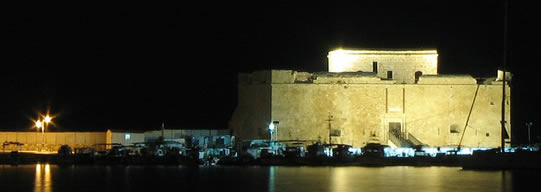
The castle of Paphos (Pafos Castle) located at the harbour of the city, was a part of the coastal defence system of Cyprus. It was originally built as a Byzantine fort to protect the harbour and rebuilt by the Lusignians in the thirteenth century. It was then dismantled in 1570 by the Venetians, who found themselves unable to defend it against the Ottomans, who in their turn restored and strengthened it after they captured the island.
The rescued part of the building is one of the two towers built by the Lusignians after the earthquake in 1222ac. One of the two towers was desolated and an earthquake destroyed it. 50 metres to the east you can see the remains of the second tower.
After its destruction was rebuilt by the Ottomans in 1592ac as you can see on the sign placed on the entrance of the fort.
The ground floor of the castle is composed of various rooms, which were used as prison cells by the Ottomans. Below the floor there are two small underground cells in where long-term convicts were held.
The first floor was used as mosque, as the rest or the rooms were used for the small Ottoman guard.
At the roof of the castle there were some canons, which were removed at the end of the Ottoman command in 1878.
During the English command the castle was used for salt storage, until 1935, when it was declared as a ancient monument. The Paphos castle is a part of the UNESCO list for cultural monuments.
The castle is open for the public every day, 10:00-17:00 in winter and 10:00 – 18:00 in summer (1 June – 31 August).



